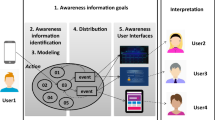Abstract
The paper discusses the notion of awarenessfrom the point of view of the design of asupportive technology. This perspectiverequires a deeper understanding of the ways andmeans people adopt to deal with awarenessinformation as well as considering theintegration of awareness tools with toolssupporting other forms of coordination. First,we suggest to consider two types of awareness:by-product awareness that is generated in thecourse of the activities people must do inorder to accomplish their cooperative tasks;and add-on awareness that is the outcome of anadditional activity, which is a neat cost forthe cooperating actors in relation to what theymust do and is discretional in that it dependson actors' evaluation of the contingentsituation. Secondly, we propose areaction-diffusion metaphor to describe theawareness phenomenology and to take intoaccount the two above-mentioned types ofawareness integration. The model ofawareness derived from the metaphor makesvisible and accessible by different types ofusers a set of elemental primitives whoseflexible composition allows them to constructthe awareness mechanisms they dynamically need. These primitives are incorporated in a softwaremodule that can be used in combination withcoordinative applications for sake of promotingawareness information. The main architectureof the module is presented together with itsinteroperability with the target application;moreover, a simple example illustrates how theincorporated primitives can be used to buildawareness mechanisms.
Similar content being viewed by others
References
Agostini, A., G. De Michelis, and A. Grasso (1997): Rethinking CSCWSystems: the Architecture of MILANO. In J. Hugues, W. Prinz, T. Rodden and K. Schmidt (eds.): 5th European Conference on CSCW, Lancaster – UK. Kluwer Academic, pp. 33–48.
Bandini, S. and C. Simone (1999): Integrating Forms of Interaction in a Distributed Coordination Model. Fundamenta Informaticae, (to appear).
Benford, S. and L. Fahlén (1993): A Spatial Model of Interaction in Large Virtual Environments. In G. De Michelis, C. Simone and K. Schmidt (eds.): 3th European Conference on CSCW, Milano – IT. Kluwer Acdemic Publishers, pp. 109–124.
Benford, S., C. Greenhalg and D. Lloyd (1997): Crowded Collaborative Virtual Environments. In CHI'97. ACM-Electronic Proceedings. (http://info.acm.org/sighchi/chi97).
Benford, S. and C. Greenhalgh (1997): Introducing Third Party Objects into the Spatial Model of Awareness. In W. Prinz, T. Rodden and K. Schmidt (eds.): 5th European Conference on CSCW, Lancaster – UK. Kluwer Academic Publishers, pp. 189–204.
Bentley, R. and P. Dourish (1995): Medium Versus Mechanisms: Supporting Collaboration Through Customization. In H. Marmolin, Y. Sunblad and K. Schmidt (eds.): 4th European Conference on CSCW, Stockholm – Sweden. Kluwer Academic, pp. 133–148.
Black, M. (1962): Models and Archetypes. In Studies in Language and Philosophy. London: Ithaca, pp. 1–16.
Bowers, J., G. Button and W. Sharrock (1995): Workflow from Within and Without: Technology and Cooperative Work on the Print Industry Shopfloor. In H. Marmolin, Y. Sundblad and K. Schmidt (eds.): 4th European Conference on CSCW, Stockholm – Sweden. Kluwer Academic Publishers, pp. 51–66.
Boyd, R. and T. Kuhn (1979): Metaphor in Science. In A. Ortony (ed.): Metaphor and Thought. Cambridge: Cambridge University Press.
Carstensen, P. and C. Sørensen (1996): From the Social to the Systematic: Mechanisms Supporting Coordination in Design. CSCW Journal, vol. 5, no. 4, pp. 387–413.
Chalmers, M. (2002): Information Awareness and Representation. CSCW Journal (in this issue).
Cugola, G. (1998): Tolerating Deviations in Process Support Systems via Flexible Enactment of Process Models. IEEE-Trans. on Software Engineering, vol. 24, no. 11, pp. 982–1001.
De Michelis, G., E. Leiva-Lobos and E. Covarrubias Gatica (1997): Augmenting and Multiplying Spaces for Creative Design. In S.C. Hayne and W. Prinz (eds.): ACM-GROUP'97, Phoenix (AZ). ACM Press, pp. 177–186.
Divitini, M. and C. Simone (2000): Supporting Different Dimensions of Adaptability in Workflow Modeling. CSCW Journal – Special Issue on 'Adaptive Worflow Systems'', vol. 9, no. 3–4, pp. 365–397.
Divitini, M., C. Simone and K. Schmidt (1996): ABACO: Coordination Mechanisms in a Multi-Agent Perspective. In Proc. Second International Conference on the Design of Cooperative Systems (COOP96), Antibes-Juan-les-Pins, France, 19–22 June1996, pp. 103–122.
Donatelli, S., M. Sarini and C. Simone (2000): Towards a Contextual Information Service supporting adaptability and awareness in CSCW systems. In R. Dieng, A. Giboin, G. De Michelis and L. Karsenty (eds.): COOP 2000, Sophia-Antipolis (Fr), pp. 83–98.
Fitzpatrick, G. and S. Kaplan (2002): Supporting Public Availability and Accessibility with Elvin. CSCW Journal (in this issue).
Fuchs, L., U. Pankoke-Babbatz and W. Prinz (1995): Supporting Cooperative Awareness with Local Event Mechanisms: the Groupdesk System. In H. Marmolin, Y. Sunblad and K. Schmidt (eds.): 4th European Conference on CSCW, Stockholm – Sweden. Kluwer Academic Publishers, pp. 247–262.
Greenhalg, C. and S. Benford (1995): MASSIVE: A Collaborative VE for Tele-Conferencing. ACM TOCHI, vol. 2, no. 3, pp. 239–261.
Grinter, R.E. (1998): Recomposition: Put It All Back Together Again. In S. Poltrock and J. Grudin (eds.): CSCW'98, Seattle – WA. ACM Press, pp. 393–402.
Gutwin, C., M. Roseman and S. Greenberg (1996): A Usability Study of Awareness Widgets in a Shared Workspace Groupware System. In M.S. Ackermann (ed.): CSCW96, Boston – MA. ACM Press, pp. 258–267.
Heath, C., J. Hindmarsh, P. Luff and D. vom Lehn (2002): Configuring Awareness. CSCW Journal (in this issue).
Heath, C., P. Luff and G.M. Nicholls (1995): The Collaborative Production of the Document: Context, Genre and the Borderline in Design. In M. Zackland (ed.): COOP95, Juan-les-Pins. INRIA, pp. 203–218.
Hughes, J., D. Randal and D. Shapiro (1992): Faltering from Ethnography to Design. In M. Mantei and R. Baecker (eds.): CSCW92, Toronto – CA. ACM Press, pp. 115–122.
Klein, M., C. Dellarocas and A. Benstein (eds.) (2000): Special Issue on 'Adaptive Workflow Systems'. CSCW Journal, vol. 9, no. 3–4.
Lakoff, G. and M. Johnson (1999): Philosophy in the Flesh. New York: Basic Books.
Mansfield, T., S. Kaplan, G. Fitzpatrick, T. Phelps, M. Fitzpatrick and R. Taylor (1997): Evolving Orbit: A Progress Report on Building Locales. In S.C. Hayne and W. Prinz (eds.): ACMGROUP' 97, Phoenix (AZ). ACM Press, pp. 241–250.
Mariani, J. (1997): SISCO: Providing a Cooperation Filter for a Shared Information Space. In S.C. Hayne and W. Prinz (eds.): ACM-GROUP'97, Phoenix (AZ). ACM Press, pp. 376–384.
Mark, G. (2002): Conventions and Commitments in Distributed Groups. CSCW Journal (in this issue).
Mark, G., L. Fuchs and M. Sohlenkamp (1997): Supporting Groupware Conventions Trough Contextual Awareness. In J. Hugues, W. Prinz, T. Rodden and K. Schmidt (eds.): ECSCW97, Lancaster. Kluwer Academic, pp. 253–268.
Nehaniv, C.L. (ed.) (1998): Computation for Metaphors, Analogy, and Agents. LNAI 1562. Berlin: Springer Verlag,.
Nomura, T., K. Hayashi, T. Hazama and S. Gudmunson (1998): Interlocus:Workspace Configuration Mechanisms for Activity Awareness. In S. Poltrock and J. Grudin (eds.): CSCW'98, Seattle – WA. ACM Press, pp. 29–38.
Okubo, A. (1980): Diffusion and Ecological Systems: Mathematical Models. New York: Springer Verlag.
Prinz, W. (1999): Nessie: An Awareness Environment for Cooperative Settings. In S. Bødker, M. Kying and K. Schmidt (eds.): 6th European Conference on CSCW-ECSCW99, Copenhagen, DK. Kluwer Academic, pp. 391–410.
Ramduny, D., A. Dix and T. Rodden (1998): Exploring the Design Space for Notification Servers. In S. Poltrock and J. Grudin (eds.): CSCW'98, Seattle – WA. ACM Press, pp. 227–335.
Rodden, T. (1996): Populating the Application: AModel of Awareness for Cooperative Applications. In M.S. Ackezmen (ed.): CSCW' 96. Boston, MA, November 16–20, 1994. New York: ACM Press, pp. 87–96.
Sandor, O., C. Bodgan and J. Bowers (1997): Aether: An Awareness Engine for CSCW. In W. Prinz, T. Rodden and K. Schmidt (eds.): 5th European Conference on CSCW, Lancaster, UK. Kluwer Academi Publishers, pp. 221–236.
Schmidt, K. (1997): Of Maps and Scripts-The Status of Formal Constructs in Cooperative Work. In S.C. Hayne and W. Prinz (eds.): ACM-GROUP'97, Phoenix (AZ). ACM Press, pp. 138–147.
Schmidt, K. (1998): Some Notes on Mutual Awareness. COTCOS-Report, Technical University of Denmark.
Schmidt, K. and C. Simone (1996): Coordination Mechanisms: Towards a Conceptual Foundation for CSCWSystems Design. CSCW Journal, vol. 5, no. 2/3.
Simone, C. and S. Bandini (1997): Compositional Features for Promoting Awareness Within and Across Cooperative Applications. In S.C. Hayne and W. Prinz (eds.): ACM-GROUP'97, Phoenix (AZ). ACM Press, pp. 358–367.
Suchman, L. (1987): Plans and Situated Actions. The Problem of Human-Machine Communication. Cambridge: Cambridge University Press.
Syri, A. (1997): Tailoring Cooperation Support Through Mediators. In J. Hughes, W. Prinz, T. Rodden and K. Schmidt (eds.): 5th European Conference on CSCW, Lancaster – UK. Kluwer Academic Publishers, pp. 157–172.
Turing, A. (1952): The Chemical Basis of Morphogenesis. Philos. Trans. R. Society, vol. 237.
Yamaashi, K., J.R. Coperstock, T. Narine and W. Buxton (1996): Beating the Limitations of Camera-Monitor Mediated Telepresence with Extra-Eyes. In CHI'96. ACM-Electronic Proceedings (http://info.acm.org/sighchi/chi96).
Author information
Authors and Affiliations
Rights and permissions
About this article
Cite this article
Simone, C., Bandini, S. Integrating Awareness in Cooperative Applications through the Reaction-Diffusion Metaphor. Computer Supported Cooperative Work (CSCW) 11, 495–530 (2002). https://doi.org/10.1023/A:1021213119071
Issue Date:
DOI: https://doi.org/10.1023/A:1021213119071




